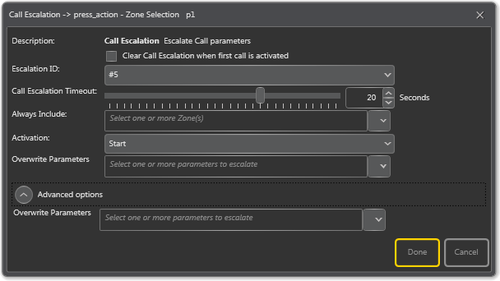Difference between revisions of "Call Escalation"
(→Call Escalation Configuration) |
|||
| Line 3: | Line 3: | ||
This function is typically used for Live Speech to escalate normal PTT use to '''''important PA'''''. | This function is typically used for Live Speech to escalate normal PTT use to '''''important PA'''''. | ||
| − | == | + | == Configuration == |
* Drag-and-drop [[:Category:Input Actions|'''Input Actions''']] > '''Call Escalation''' to: | * Drag-and-drop [[:Category:Input Actions|'''Input Actions''']] > '''Call Escalation''' to: | ||
'''[[:Category:Access Panels|Access Panel]]''' > '''Programmable Keys''' > '''p1-px > press_action/release_action''' | '''[[:Category:Access Panels|Access Panel]]''' > '''Programmable Keys''' > '''p1-px > press_action/release_action''' | ||
Revision as of 11:22, 2 May 2018
Call Escalation is a special input function that can be used to modify (escalate) call parameters, for example, to raise the priority of a Live Speech, Audio Program Control, or Message Control function.
Call Escalation is local to the access panel so it is not possible to escalate across different panels.
This function is typically used for Live Speech to escalate normal PTT use to important PA.
Contents
Configuration
- Drag-and-drop Input Actions > Call Escalation to:
Access Panel > Programmable Keys > p1-px > press_action/release_action
The Escalation ID parameter on the Call Escalation function must correspond to the Escalation ID parameter on the input action that will be escalated.
When this is triggered, the function with the corresponding ID will get the new priority.
Clear Call Escalation when first call is activated
If the box is checked, the escalation state will be cleared when the call starts. If the box is unchecked, the escalation state will toggle.
Escalation ID
Identifies which calls will be modified by the escalation function.
Call Escalation Timeout
The time in seconds in which the call escalation function is active before it times out.
Overwrite Parameters
This replaces the selected value in the broadcasts.
Call Escalation Examples
Example 1: Change Priority and Chime
This example will change the chime and priority of the live speech function used on an access panel.
This is typically used if the live speech function defaults to normal chime and normal priority, and the access panel needs a way of escalating this to increase priority above ongoing alarms.
- Escalation ID: This must be the same as for the live speech function it refers to on the access panel.
- Call Escalation Timeout: 5 seconds
- Overwrite Parameters: Chime, Priority
- Chime: Chime 2
- Priority: 1
When the escalation function is triggered, it will change the chime to Chime 2 and priority to Priority 1 on the live speech function.
If the live speech key is pressed before the timeout of 5 seconds, it will be activated with the new parameters. If more than 5 seconds have passed after the escalation function was started, the live speech function will fall back to the original parameters.
Example 2: Always Include and Clear Call Escalation after Use
This example will change the chime and priority of the live speech function used on an access panel only once.
Live speech is commonly used together with dynamically selected zones, so by including Always Include zones, this will ensure that some zones are always included together with the dynamically selected zones.
- Escalation ID: This must be the same as for the live speech function it refers to on the access panel.
- Call Escalation Timeout: 5 seconds
- Always Include: Zone 1
- Overwrite Parameters: Chime, Priority
- Chime: Chime 2
- Priority: 1
When the escalation function is triggered, it will change the chime to Chime 2 and priority to Priority 1 on the live speech function.
It will also ensure that Zone 1 is always included together with any other zones selected.
If the live speech key is pressed before the timeout of 5 seconds, it will be activated with the new parameters. If more than 5 seconds have passed after the escalation function was started, the live speech function will fall back to the original parameters. The live speech will also fall back to original parameters after it is used.
Example 3: Static Zone Selection
This example will change which zones the live speech function is sending audio to.
This is normally used when live speech during alarms should go to all zones regardless of dynamically selected zones.
The difference between Always Include and Overwrite Parameters: Destination is that the latter will ensure audio is sent to only those zones.
- Escalation ID: This must be the same as for the live speech function it refers to on the access panel.
- Overwrite Parameters: Destination
- Destination: All Zones
When the escalation function is triggered, it will change the destinations on the live speech function to a static set of zones.
